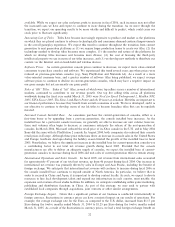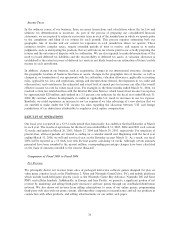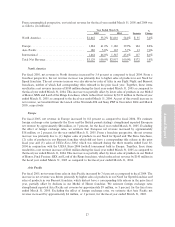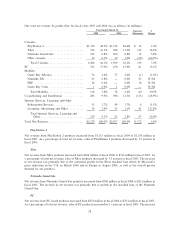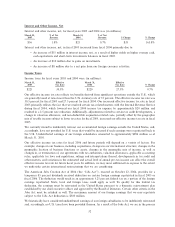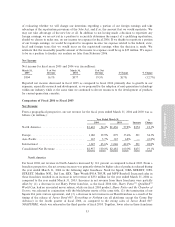Electronic Arts 2005 Annual Report Download - page 82
Download and view the complete annual report
Please find page 82 of the 2005 Electronic Arts annual report below. You can navigate through the pages in the report by either clicking on the pages listed below, or by using the keyword search tool below to find specific information within the annual report.
Income Taxes
In the ordinary course of our business, there are many transactions and calculations where the tax law and
ultimate tax determination is uncertain. As part of the process of preparing our consolidated Ñnancial
statements, we are required to estimate our income taxes in each of the jurisdictions in which we operate prior
to the completion and Ñling of tax returns for such periods. This process requires estimating both our
geographic mix of income and our current tax exposures in each jurisdiction where we operate. These
estimates involve complex issues, require extended periods of time to resolve, and require us to make
judgments, such as anticipating the positions that we will take on tax returns prior to our actually preparing the
returns and the outcomes of disputes with tax authorities. We are also required to make determinations of the
need to record deferred tax liabilities and the recoverability of deferred tax assets. A valuation allowance is
established to the extent recovery of deferred tax assets is not likely based on our estimation of future taxable
income in each jurisdiction.
In addition, changes in our business, such as acquisitions, changes in our international structure, changes in
the geographic location of business functions or assets, changes in the geographic mix of income, as well as
changes in, or termination of, our agreements with tax authorities, valuation allowances, applicable accounting
rules, applicable tax laws and regulations, rulings and interpretations thereof, developments in tax audit and
other matters, and variations in the estimated and actual level of annual pre-tax income can aÅect the overall
eÅective income tax rate for future Ñscal years. For example, in the three months ended March 31, 2004, we
resolved certain tax-related matters with the Internal Revenue Service, which lowered our income tax expense
by approximately $20 million and resulted in a 2.5 percent rate reduction for the Ñscal year ended March 31,
2004. By contrast, adverse developments in audits or applicable law result in increases in our tax expense.
Similarly, we could experience an increase in our tax expense if we take advantage of a new election that we
are entitled to make under the U.S. income tax rules regarding the allocation between U.S. and foreign
jurisdictions of tax deductions attributable to employee stock option compensation.
RESULTS OF OPERATIONS
Our Ñscal year is reported on a 52/53-week period that, historically, has ended on the Ñnal Saturday of March
in each year. The results of operations for the Ñscal years ended March 31, 2005, 2004 and 2003 each contain
52 weeks and ended on March 26, 2005, March 27, 2004 and March 29, 2003, respectively. For simplicity of
presentation, all Ñscal periods are treated as ending on a calendar month end. Beginning with the Ñscal year
ending March 31, 2006, we will end our Ñscal year on the Saturday nearest March 31. As a result, our Ñscal
2006 will be reported as a 53 week year with the Ñrst quarter containing 14 weeks. Although certain amounts
presented have been rounded to the nearest million, corresponding percentage changes have been calculated
on the basis of amounts rounded to the nearest thousand.
Comparison of Fiscal 2005 to Fiscal 2004
Net Revenue
We principally derive net revenue from sales of packaged interactive software games designed for play on
video game consoles (such as the PlayStation 2, Xbox and Nintendo GameCube), PCs and mobile platforms
which include hand-held game players (such as the Nintendo Game Boy Advance, Nintendo DS and Sony
PSP) and cellular handsets. Additionally, in Europe and Asia PaciÑc, we generate a signiÑcant portion of net
revenue by marketing and selling third-party interactive software games through our established distribution
network. We also derive net revenue from selling subscriptions to some of our online games, programming
third-party web sites with our game content, allowing other companies to manufacture and sell our products in
conjunction with other products, and selling advertisements on our online web pages.
26








